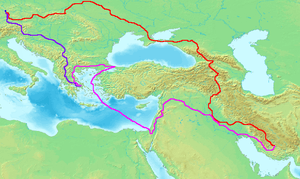Petachiah of Regensburg
Petachiah of Regensburg, also known as Petachiah ben Yakov, Moses Petachiah, and Petachiah of Ratisbon, was a Bohemian rabbi of the twelfth and early thirteenth centuries CE. He is best known for his extensive travels during the late twelfth century throughout Eastern Europe, the Caucasus, and the Middle East, and the travelogue he wrote during his travels. He visited places such as Poland, Russia, Syria, Armenia, and Greece, of which he divulges in his travel log titled the Travels of Rabbi Petachia of Ratisbon.[1]
Petachiah was born in Regensburg in Bavaria, a city whose Jewish community was so renowned for its piety and learning that it was sometimes called the "Jewish Athens". He was the brother of Rabbi Yitzhak ha-Lavan ("the White") ben Yaakov, a renowned Jewish jurist. During his childhood he was probably tutored by such scholars as Judah the Pious (Yehuda ben Shmuel), who is also thought to have traveled with him for a time, and who is credited with compiling a report of Petachiah's journey.[2] The Bohemian rabbi entrusted Judah the Pious with his travel notes which was then turned to the aforementioned travel log.[3] He was the author of several glosses on the Talmud. As a young man he left Regensburg and settled in Prague.
The dates of the travels described in his travelogue are uncertain, but are placed roughly between the years 1170 and 1187.[2] He probably set out from Prague sometime between 1170 and 1180, and was certainly in Jerusalem prior to 1187, since he describes it as being under the control of the Latin Kingdom of Jerusalem. As Judah the Pious is supposed to have made the surviving manuscript copy of Petachiah's travelogue, he must have returned to Regensburg prior to that sage's death in 1217. Petachiah was recognized by sources as a merchant and it is thought that he, along with the other Jewish merchants of Regensburg, played a part in the development of a trade route that extended from Mainz to Kiev.[4] Some of Petachiah's travelogue is devoted to discussing the oppression of Jews and the struggles they often faced in Greece and other neighboring lands.[1]

Petachiah traveled east from Bohemia, through Poland, Ruthenia, southern Ukraine (which he called Kedar), and the Crimeaan Gazaria (Genoese colonies). He describes the remnants of the Khazars and the early Crimean Karaite community. He then went south through the Kipchak khanates and the Caucasus into Armenia, sojourning for a while in Nisibis. From there he traveled to Mesopotamia, visiting Nineveh, Sura, Pumbedita, and Baghdad before moving on to Persia. Turning westward, he journeyed up the Euphrates and into Syria, visiting Aleppo and Damascus. He traveled onward to the Kingdom of Jerusalem, visiting holy sites in the Galilee and Judea, whence he may have taken to the sea. The next place he describes is Greece. From there, presumably, he returned home via the Balkans.[5]
The date of Petachiah's death is unknown but could be around 1225.
See also
Sources
- 1 2 1150-1217., Judah ben Samuel, approximately (2012). Travels of Rabbi Petachia of Ratisbon : who, in the latter end of the twelfth century, visited Poland, Russia, Little Tartary, the Crimea, Armenia, Assyria, Syria, the Holy Land, and Greece. Benisch, A. (Abraham), 1811-1878., Ainsworth, William, 1807-1896., Pethahiah, of Regensburg, active 1175-1190. Piscataway: Gorgias Press. ISBN 9781611439113. OCLC 712630312.
- 1 2 Adler, Elkan Nathan (2016). Jewish Travellers in the Middle Ages. New York: Dover Publications, Inc. p. 64.
- ↑ Zunz, in Asher's Itinerary of Benjamin of Tudela, ii. 253
- ↑ Brutzkus, J. (1943). "Trade with Eastern Europe, 800-1200". The Economic History Review. 13 (1/2): 31–41. doi:10.2307/2590513. JSTOR 2590513.
- ↑ Gottesman, Brian. "Jewish Travelers in the early Middle Ages."
- . Benisch. Travels of Petachia of Ratisbon (with English translation.) London, 1856.
External links
- Travels of Rabbi Petachia of Ratisbon, online version of a bilingual 1856 edition.